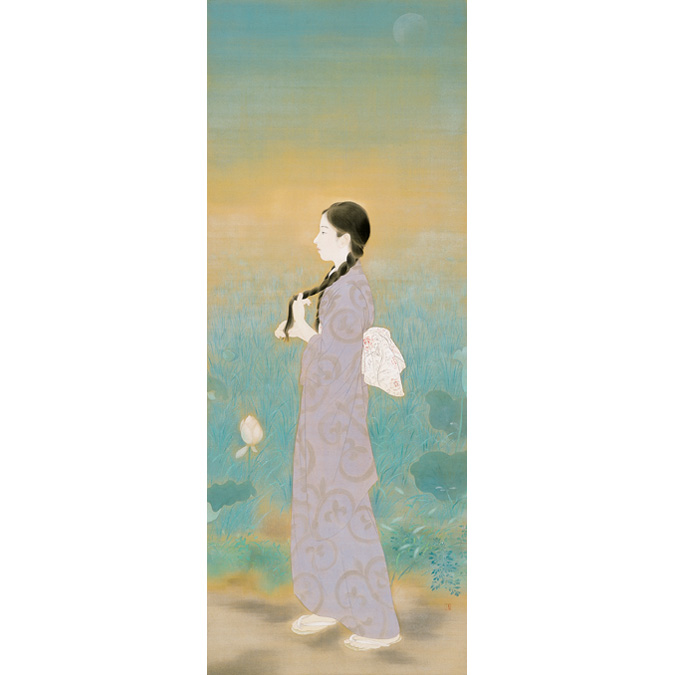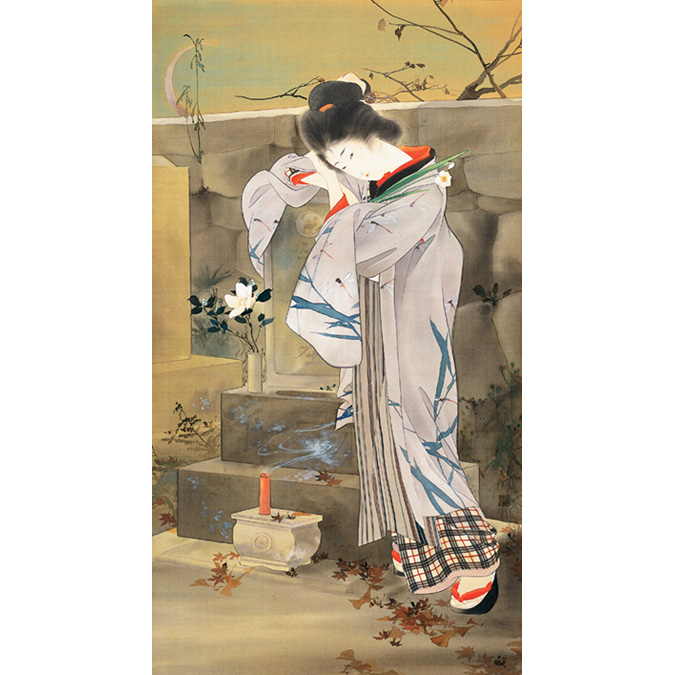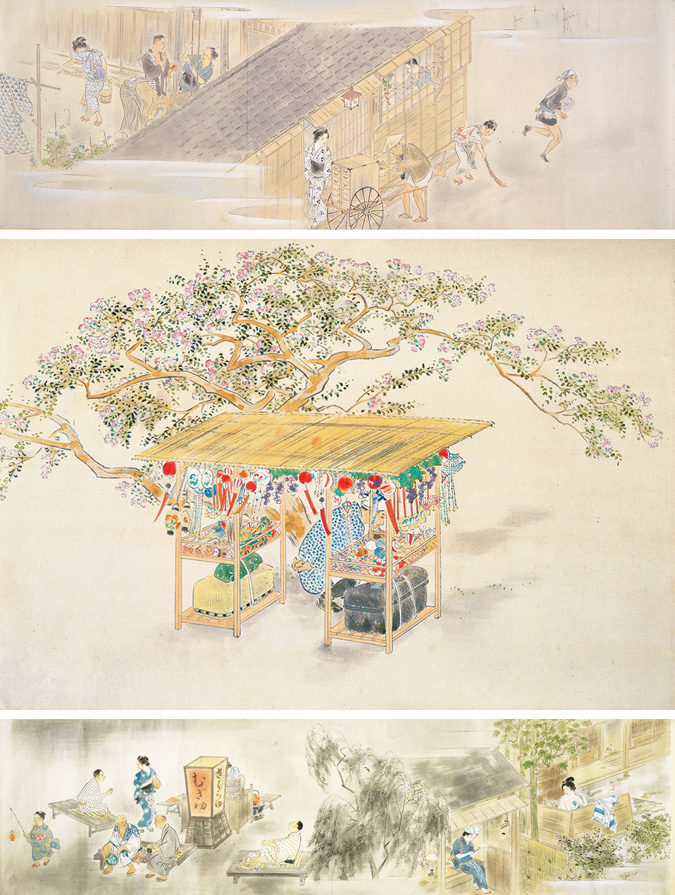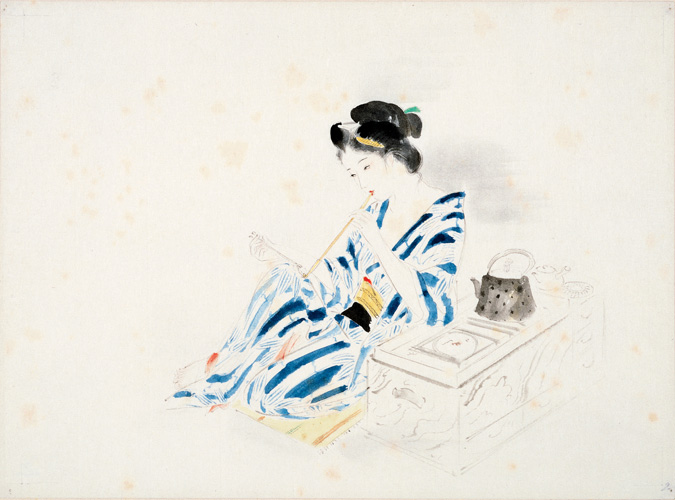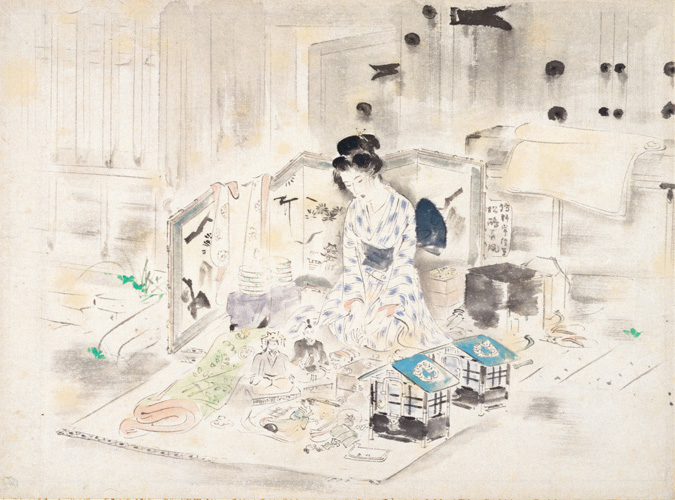-
Asasuzu
Cool of the Morning
-
Taisho 14(1925)
Silk/Hanging scroll
219.0 × 83.5cm
The 6th of the government-sponsored Imperial Academy Art Exhibition
Kiyokata showed this work, one of his masterpieces, at the government-sponsored Imperial Academy Art Exhibition (Teiten). He used to say that whenever he felt doubts about his work, he would recover by looking at this painting.
The painting is based on life at Kiyokata’s summer home at Kanazawa Hakkei (now Kanazawa-ku in Yokohama). It was his habit to take walks in the company of his oldest daughter early in the morning when the moon was still visible in the sky. A lotus blooms among the expanse of paddy fields behind the figure of Kiyokata’s daughter.
-
Ichiyō no haka
The Grave of Higuchi Ichiyō
-
Meiji 35(1902)
Silk/Hanging scroll
128.7 × 71.0cm
The 5th Ugokai Exhibition
Inspired by Izumi Kyōka’s story Ichiyō no haka (The Grave of Ichiyō, published in Shin Shosetsu magazine, 1900), Kiyokata drew on his recollections of visiting the Higuchi family grave, which at that time was located at Tsukiji Honganji Temple.
In the margins of the sketchbook he carried with him, he noted that, “the grave stone reaches as high as my chest.” The figure of Midori, the heroine of Higuchi Ichiyō’s novel Takekurabe (Child’s Play), leaning against the gravestone of Higuchi Ichiyō dates back to this sketch. The narcissus that Midori holds in her hand refers to a scene in the final chapter of Child’s Play when Midori finds a paper narcissus pushed through the lattice gate in the morning of the day when the boy Shin’nyo leaves to begin his training at a Buddhist seminary.
-
Chōseki Ankyo
Daily Life in the Meiji Period
-
Showa 23(1948)
Paper/Scroll
Morning 42.2 × 124.0cm/
Noon 42.2 × 60.5cm/
Night 42.2 × 158.6cm
The 4th Japan Fine Arts Exhibition
The topic is daily life in the quiet neighborhoods of Tokyo, where the atmosphere of Edo was still much in evidence in the 1880s and 1890s, not so long after Japan had opened to the outside world. Kiyokata has created a picture scroll that tracks the time of day from left to right in three scenes that depict his boyhood recollections of the customs of a summer morning, noon and evening.
Morning: A tenement house in the early morning. The masts of a sailing ship are visible on the right. The newspaper boy on the right is clasping copies of the Yamato Shimbun, the newspaper that Kiyokata’s father managed. In the center, a vendor of boiled beans is selling pre-cooked dishes, and on the right, a few neighbors are gathered around the well, chatting as they attend to their morning toilette. A woman is seen drawing water from the well, the first task of the day.
Noon: A vendor of wind chimes has put down his load of wind chimes and paper lanterns and is now resting in the shade of a crape myrtle.
Evening: In a garden, a woman is taking a bath shielded behind a pair of propped up shutter doors in the shade of a rose of sharon in bloom. A crescent moon hangs in a clear sky. Another woman is cleaning lamp chimneys, seated in a doorway by a willow tree with bats flying among its branches. The scene on the left depicts customers enjoying the evening cool at the Mugiyu tea stall.
-
Nigorie
Troubled Waters
-
Showa 9(1934)
Paper/Pasteboard
26.2 × 35.5cm for each
The 3rd of Rikuchokai Exhibition
〔Summary〕
Oriki, the leading attraction at the Kikunoi brothel, is captivated by the manly and generous Yūki Tomonosuke. When Genshichi, an admirer who has ruined himself on Oriki’s account, comes to call, she refuses to see him. When Genshichi’s wife Ohatsu throws away a cake that Oriki has given to their son, Genshichi drives his wife and son out of the family home. Genshichi kills Oriki as she returns from the bathhouse, then commits ritual suicide.
Rereading Higuchi Ichiyo’s novel Troubled Waters (1895), Kiyokata found these images welling up and, before he knew it, flowing through his brush and onto the paper.
The work is composed of a preface in which Kiyokata discusses the process of illustrating the novel, and fifteen images. Kiyokata had read and reread Ichiyo’s Child’s Play and Troubled Waters any number of times since boyhood. The stories were more than reading matter to him—he harbored a deep admiration for Ichiyo and produced several works based on her stories during his career, from the early years of his artistic training until three years before his death.
-
Chūmonchō
The Order Book
-
Showa 2 (1927)
Paper/Pasteboard
25.1 × 34.0cm for each
The 12th Kyodokai Exhibtion
〔Summary〕
After the Meiji restoration, Onui, the daughter of a former retainer of the shogun, turns to prostitution. On the nineteenth day of the month, she plans to commit double suicide with a man she has met, but the man survives. As times passes, many sinister events involving razors occur in the red-light district, and Gosuke, the knife sharpener, has come to fear the anniversary of the death. On the nineteenth, a day when he normally accepts no work, he sharpens a razor for Owaka at the House of the Scarlet Plum, and by doing so, transfers the ghost of Onui to Owaka. When Wakinoya Kinnosuke (the nephew of the man who survived the double suicide) shelters at the house after losing his way in the snow late at night, she lures him to his death.
”Tabletop Art”
Kiyokata referred to Daily Life in the Meiji Period and other works as “tabletop art,” which he explained as small objects that could be spread out on a table and enjoyed down to the smallest brushstroke in the privacy of your own home. Other examples of Kiyokata’s tabletop art include the series Troubled Water and The Order Book, as well as illustrations, frontispieces, and books of paintings.
Kiyokata produced a work consisting of thirteen sheets based on Izumi Kyoka’s novel The Order Book (1901). Since an acquaintance introduced Kiyokata to the novelist in 1901, their good combination, Kyōka-saku Kiyokata-egaku (written by Kyōka, illustrated by Kiyokata) had begun on frontispieces and illustrations for books and magazines.
The two men remained friends until Kyoka’s death in 1939.
